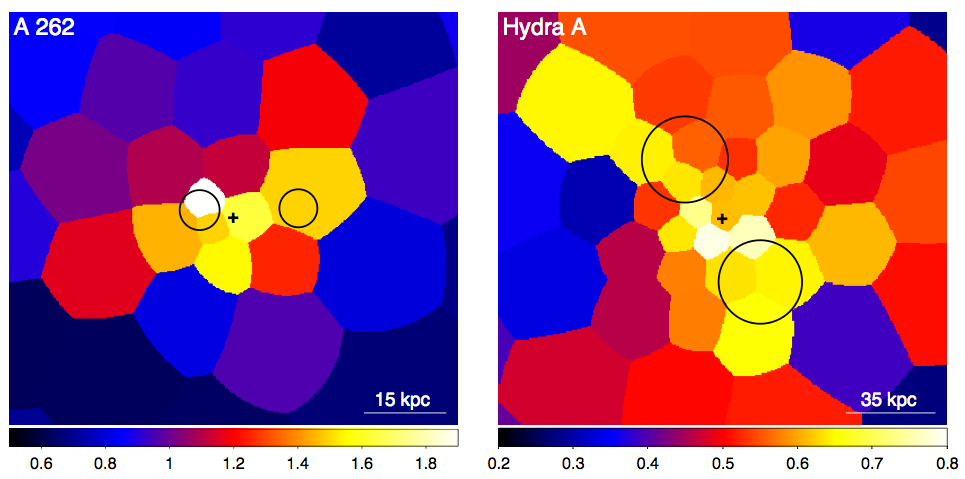Title: Exploring cosmic anisotropy with galaxy clusters
Authors: K. Migkas, G. Schellenberger, T. H. Reiprich, F. Pacaud, M. E. Ramos-Ceja and L. Lovisari
First author’s institution: Argelander-Institut für Astronomie, Universität Bonn, Bonn, Germany
Status: Accepted to Astronomy & Astrophysics, open access on arXiv
One of the key properties of our cosmos is that it is isotropic. This means the universe is expected to look the same whichever direction you look, and therefore has no preferred direction or centre. Another property states that the universe is homogeneous – everything looks roughly the same at every point in space. The fulfilment of these two properties over large distances forms the basis of the cosmological principle.
This fundamental pillar of our cosmological model is reinforced by observations of leftover light from the Big Bang, known as the cosmic microwave background. which is impressively uniform. However, measurements of its anisotropy at very small scales have been used to challenge the cosmological principle – see this Astrobite for more.
An important consequence of isotropy is that the expansion of the universe must be the same in every direction. Today’s paper investigates just how constant this expansion is using the largest objects in our cosmos. If the expansion is found to be different depending on where one looks, it could point towards a more anisotropic universe than previously believed, which could have implications for how our universe evolved.
Clusters of galaxies are the biggest gravitationally bound objects in the Universe. These vast, swirling arrangements of red, elliptical galaxies emit brightly in the form of visible starlight. In between these galaxies, a hot energetic gas also radiates in X-rays, which can be observed by space telescopes such as XMM-Newton and Chandra, and used as a detectable signature for a galaxy cluster.
A sky full of clusters
Today’s paper assembles a homogeneously selected sample of 313 galaxy clusters, containing 237 observed by Chandra and 76 observed by XMM, to search for evidence that the universe might not be expanding uniformly in all directions.
The authors use the fact that the temperature of the hot gas in a galaxy cluster has a strong, positive relationship with the X-ray luminosity it radiates. In other words, the hotter the gas, the more luminous the cluster. By fitting a model to the cluster spectrum, it is possible to measure the temperature. Crucially, the temperature of a cluster can be obtained without any assumption about the underlying cosmology. Then, by the relation above, you can predict the luminosity.
The predicted luminosity for a cluster at a given temperature and redshift also depends on a (constant) value A, called the normalisation. We can obtain this value from the luminosity and redshift via the luminosity distance. The resulting value of A is directly related to the expansion of the universe (denoted by H0).
Dividing the sky into slices, the authors study the distribution of temperatures and luminosities, measuring a value for A in each region. In physical terms, a lower/higher value of A means that clusters in some regions are less/more luminous for a fixed temperature. If any significantly different values of A are reported, it could imply that the universe is expanding at a different rate in some parts of the sky than others, and hence showing evidence that our universe might not be isotropic.
Cosmic expansion might be lumpy
After computing the value of A, and hence H0 in each patch of sky, the authors find that one region (shown in purple), displays a significantly different value to the remainder of the sky. The discrepancy in values for the expansion rate is between ~ 66 km/s/Mpc to 75 km/s/Mpc, which is equal to a ~13% difference. This produces a statistically significant tension, meaning there is less than 1% chance that either of these measured values are a fluke.
They go on to repeat this test using an even larger set of galaxy clusters (842) consisting of three independent datasets to see whether the trend persists. They find that it does. Moreover, they find that evidence of a cosmic anisotropy in this particular direction has been discovered previously using other objects such as supernovae, infrared galaxies and quasars.
Not so fast
Today’s paper shows that X-ray observations of galaxy clusters have identified a direction in the sky that might be expanding more slowly relative to others. However, the authors acknowledge the possibility of underestimating cluster luminosities (which result in a lower value for H0), due to various reasons. One reason is differences in the cluster properties. For example, some clusters have low temperatures or high redshifts, both of which affect their luminosity. Another possibility is the interstellar medium of the Milky Way, which consists mostly of hydrogen. Galactic hydrogen absorbs X-ray emission from clusters, making them appear fainter. Finally, gravitational attraction between nearby clusters could dominate over the cosmic expansion at small distances, creating the appearance of local anisotropies. A combination of these effects is not strictly ruled out by the authors’ findings, though each of these effects have been tested individually.
This is the first time the luminosity-temperature relation for galaxy clusters has been used to test the isotropy of the universe (building on an earlier study by the same authors). Future studies will rely on understanding the nature of extragalactic absorption from the gas and dust clouds within and beyond our Milky Way in more detail, in addition to collecting even a larger number of clusters to tell us just how uniform the cosmic expansion actually is.




